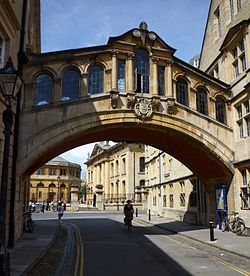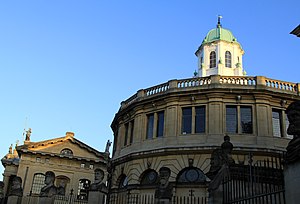Oxford: Difference between revisions
No edit summary |
Infobox etc |
||
| Line 1: | Line 1: | ||
{{Infobox town | |||
|name= Oxford | |||
|county=Oxfordshire | |||
|picture=Oxford - Bridge of Sighs- Hertford College, Passes over New College Lane.jpg | |||
|picture caption =The Bridge of Sighs over New College Lane | |||
|os grid ref=SP513061 | |||
|latitude= | |||
|longitude= | |||
|post otwn=Oxford | |||
|post code=OX | |||
|dialling code= 01865 | |||
|LG district=Oxford | |||
|constituency= | |||
}} | |||
[[File:Sheldonian Theatre 2009 LL.jpg|thumb|right|The Sheldonian Theatre in 2009]] | |||
[[File:High Street in Oxford by Night 2009 LL.jpg|thumb|right|Night view of High Street at Christmas]] | |||
Noted for its dreaming spires, the city attracts | '''Oxford''' is a university city, and the county town of [[Oxfordshire]]. It has achieved worldwide fame from its mediaeval university which dominates and shapes the city centre. The [[University of Oxford]] is the oldest university in the English-speaking world. | ||
Noted for its dreaming spires, the city attracts vast numbers of tourists who visit the University and many sites of interest. The Royalist capital in the Civil War, Oxford has had many notable roles and seen countless notable people throughout its ancient history. | |||
The city stands on the north bank of the [[River Thames]], where the [[River Cherwell]] meets it. For a distance of some 10 miles along the river, in the vicinity of Oxford, the Thames is known as ''The Isis'', apparently an affectation invented by the scholars of Oxford University. It is the largest town in Oxfordshire, and indeed the largest town on the Thames above [[Middlesex]]. Though famed for scholarship, it is a town of industry too. | |||
Buildings in Oxford demonstrate an example of every British architectural period from Anglo-Saxon to the twenty-first century. The grandest buildings are those of the university, including the iconic, mid-18th century Radcliffe Camera, the Sheldonian Theatre, the buildings of the Bodlean Library, and the individual colleges. The soaring, harmonious architecture of Oxford's university buildings inspired the poet Matthew Arnold to name Oxford the "city of dreaming spires". | |||
==Universities and education== | |||
===The University of Oxford=== | |||
'''The University of Oxford''' is the oldest university in the English-speaking world. It contains 38 colleges and 6 permanent private halls, found in and around the city centre. | |||
===Other institutions=== | |||
In the 1990s the Oxford Polytechnic became "Oxford Brookes University" (which has no connection to the ancient university). The city also plays host to Ruskin College. | |||
Oxford is home to wide range of schools many of which receive pupils from around the world. Three are University choral foundations, established to educate the boy choristers of the chapel choirs, and have kept the tradition of single sex education. Examination results in state-run Oxford schools are consistently below the national average and regional average. However, results in the city are improving with 44% of pupils gaining 5 grades A*-C in 2006. | |||
==References== | |||
{{reflist}} | |||
{{stub}} | {{stub}} | ||
Revision as of 20:56, 15 November 2010
| Oxford | |
| Oxfordshire | |
|---|---|
 The Bridge of Sighs over New College Lane | |
| Location | |
| Grid reference: | SP513061 |
| Data | |
| Dialling code: | 01865 |
| Local Government | |
| Council: | Oxford |


Oxford is a university city, and the county town of Oxfordshire. It has achieved worldwide fame from its mediaeval university which dominates and shapes the city centre. The University of Oxford is the oldest university in the English-speaking world.
Noted for its dreaming spires, the city attracts vast numbers of tourists who visit the University and many sites of interest. The Royalist capital in the Civil War, Oxford has had many notable roles and seen countless notable people throughout its ancient history.
The city stands on the north bank of the River Thames, where the River Cherwell meets it. For a distance of some 10 miles along the river, in the vicinity of Oxford, the Thames is known as The Isis, apparently an affectation invented by the scholars of Oxford University. It is the largest town in Oxfordshire, and indeed the largest town on the Thames above Middlesex. Though famed for scholarship, it is a town of industry too.
Buildings in Oxford demonstrate an example of every British architectural period from Anglo-Saxon to the twenty-first century. The grandest buildings are those of the university, including the iconic, mid-18th century Radcliffe Camera, the Sheldonian Theatre, the buildings of the Bodlean Library, and the individual colleges. The soaring, harmonious architecture of Oxford's university buildings inspired the poet Matthew Arnold to name Oxford the "city of dreaming spires".
Universities and education
The University of Oxford
The University of Oxford is the oldest university in the English-speaking world. It contains 38 colleges and 6 permanent private halls, found in and around the city centre.
Other institutions
In the 1990s the Oxford Polytechnic became "Oxford Brookes University" (which has no connection to the ancient university). The city also plays host to Ruskin College.
Oxford is home to wide range of schools many of which receive pupils from around the world. Three are University choral foundations, established to educate the boy choristers of the chapel choirs, and have kept the tradition of single sex education. Examination results in state-run Oxford schools are consistently below the national average and regional average. However, results in the city are improving with 44% of pupils gaining 5 grades A*-C in 2006.
References

This Oxfordshire article is a stub: help to improve Wikishire by building it up.